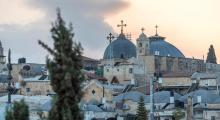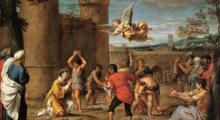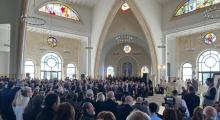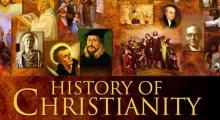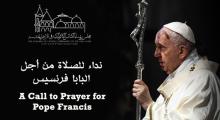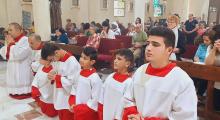Issued by the Catholic Center for Studies and Media - Jordan. Editor-in-chief Fr. Rif'at Bader - موقع أبونا abouna.org
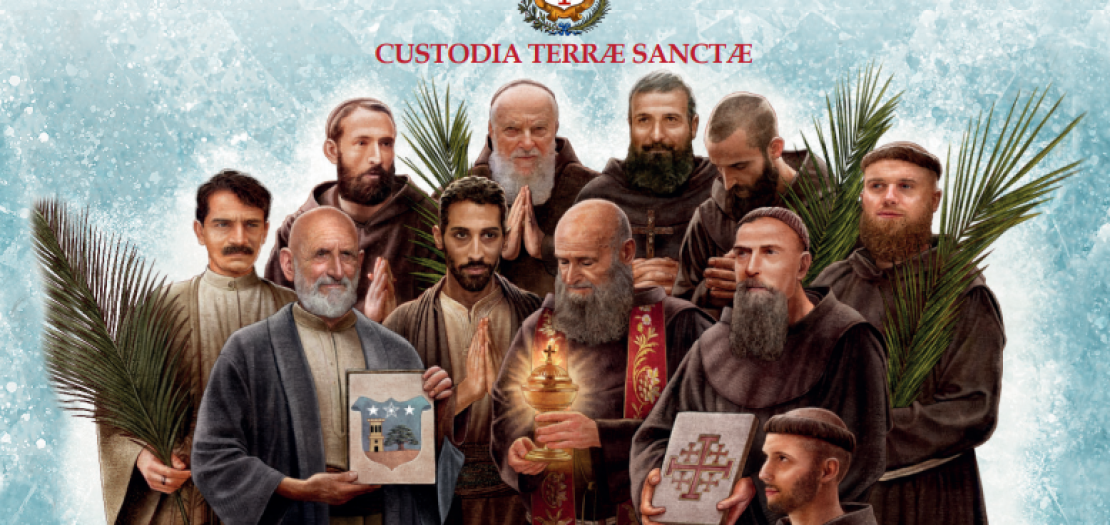
They are martyrs and witnesses of the faith, men who exercised Christian virtues heroically and lived a life of holiness. About fifteen Franciscan friars whose lives are intertwined, at least in part, with the Holy Land and the mission of the Custody, who have been raised to the honor of the altars.
At the end of the 19th century, the paths of the blessed Salvatore Lilli, the blessed Frédéric Janssoone and the blessed Mamerto Esquiú cross in Jerusalem. Eight Franciscans die as martyrs in the same period in Damascus. In the middle of the 20th century, the blessed Gabriele Allegra, who translated the Bible into Chinese, came into contact with the Custody, in particular with the Studium Biblicum Franciscanum, of which he opened a branch in Hong Kong, even though only for a few years.
“We can say that they are all missionaries. They arrived in the Holy Land by ways that are even mysterious and here they delivered their life,” said Fra Ulise Zarza, vice- postulator of the saints of the Custody of the Holy Land.
The multitudes of martyrs
St. Nicholas Tavelic and his companions (his confrères Deodato, Stephen and Peter) are considered the “protomartyrs” of the Custody. From different European countries, they arrived in Jerusalem in 1383, destined for the convent of the Cenacle, on Mount Zion, the first seat of the new-born Custody of the Holy Land (established in 1342). In 1391, the four friars were burnt alive for having borne witness to the Christian religion before the Saracens.
The second group of martyrs is that of Sts Manuel Ruiz and his companions, canonized on 20 October this year. The eight friars, an entire community, embraced the ordeal of martyrdom with faith, in Damascus in 1860, refusing to convert to Islam and dying “as Christians.”
Lastly, the blessed Salvatore Lilli, killed out of hatred for the faith in Turkey together with seven lay Armenian faithful. After arriving in the Holy Land in 1873 at the age of twenty, he was trained in Bethlehem and in Jerusalem, until his ordination as a priest. He served in a number of shrines, until he was sent to Turkey, where he died a martyr on 22 November 1895, killed by Ottoman soldiers.
“His martyrdom, together with some faithful of his parish, speaks of the life given by the Shepherd together with his sheep,” Fra Ulise emphasizes. Blessed Salvatore Lilli “can say a lot to friars in formation, especially for his missionary spirit, which was not extinguished when he arrived in the Holy Land, but which grew up to giving himself in martyrdom.”
Good Father Frédéric
Blessed Frédéric Janssoone was a missionary in the Holy Land for several years, where he also occupied important roles in the Custody, such as that of head of the Status Quo and Vicar of the Custody. Even when he was alive, he was famous for his holiness, and he was called “good Father Frédéric”.
“He left some very significant traces of his presence,” Fra Ulise tells us. “He stood out for his capacity to relate to others and dialogue with them. We owe the building of St Catherine’s church in Bethlehem to his capacity of meditation. He was the one who started the Via Crucis on Good Friday through the streets of Jerusalem. He was well-known as a preacher and guide of pilgrims.”
He also initiated the Commissariat of the Holy Land in Canada. He brought back the presence of the Friars Minor to the American continent and founded the shrine of Trois-Rivières dedicated to Our Lady of the Rosary. “He lived the mission here in the first person and in Canada he continued to support the Holy Land, promoting the Collection and spreading devotion for the Holy Places.”
With Mamerto Esquiú in the heart of the Holy Places
Blessed Mamerto Esquiú was a “pilgrim” in the Holy Land for a year and a half between 1876 and 1877, including in the (failed) attempt) to avoid being appointed Bishop in Argentina. He describes his experience, especially in the shrines, in his diary. “You feel the presence of the Lord in a very particular way,” he says of the Sea of Galilee. “It seems that you can see Him walking on the waters.”
He also did very humble work in the shrines, but above all, he identified with each Holy Place’s spirituality. Fra Ulise says: “In Nazareth, he tried to learn the virtues of the Holy Family. In Bethlehem, as he was celebrating Mass, he felt illuminated by a spiritual light that told him that in the Eucharist there was the same Child that had been born there”.
“His figure,” Fra Ulise emphasizes, “tells us how to live our service in the shrines: not to restrict ourselves to doing something because we were asked by the Church, but to assimilate, examine in further depth and enter into the Mystery of each shrine.”
Women in pole position
Fra Ulise is working on the cause of canonization of the Poor Clare Sister Maria della Trinità, of the Jerusalem monastery. It is not a cause of the Custody, but he has been appointed vice postulator, also due to the common belonging to the Franciscan family. “She is a figure to rediscover,” he says. “Despite her young age and the short period of monastic life, she had a very intense spiritual life. She had mystic experiences, she heard the inner voice of Jesus.”
The other female figure is that of Paolina de’ Marchesi Nicolay, a Franciscan tertiary. Her cause is at a standstill at the moment, but this woman helped the Custody by making a decisive contribution to the purchase of the land of Emmaus and obtaining the title of Basilica for the shrine.
Saints in “formation”
Fra Ulise is also the Master of formation of the Franciscans of the Custody. “The path of formation has to help the candidate choose once and for all the Franciscan lifestyle, which entails and requires holiness,” he says. Even if not directly, the friars are invited to take the path of holiness, through studying and exploring in depth the Franciscan charisma – from the Admonitions to the Rule, to the Constitutions of the Order.
“All these elements are like small twigs that we throw into the fire to remind us that our holiness passes from what we have promised and that we have embraced voluntarily. Then there is the life in fraternity and the ordinary instruments that the Church puts at the disposal of everyone: spiritual retreats, exercises, spiritual readings and the sacraments.”
“Holiness is not something personal, to be lived in one’s own interior: we are called to become saints in the community as well. Holiness is a style of life to embrace, also as fraternity. I think that this is the strongest message of our saints and our blessed.”


